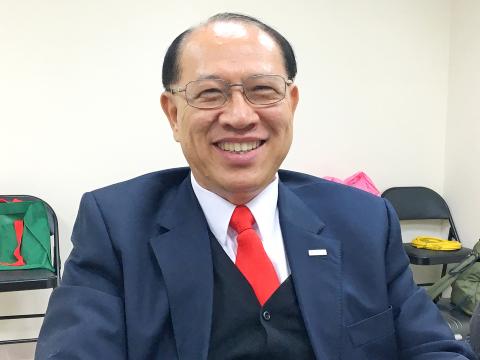Machinery maker Hiwin Technologies Co (上銀科技), which has set up branches in nine countries, on Friday said that seeking investment opportunities in Japan would be its top priority this year.
“We are considering purchasing a plot of 7,800 ping [25,785m2] in Kobe, Japan, to build an innovation center, warehouses and ball screw production lines, and to better serve customers there,” Hiwin chairman Eric Chuo (卓永財) said at the company’s annual banquet for staff in Taichung.
Hiwin is also considering building plants in Japan’s Aichi Prefecture, he said, adding that the company plans to finalize its decision in the third quarter of this year at the earliest.

Photo: CNA
The company also aims to cement its position in Japan by acquiring a Japanese machinery maker by the end of this year, Chuo said, adding that in the coming months, Hiwin plans to expand capacity in South Korea and Italy, where it already has subsidiaries.
“To fund those overseas projects, we do not rule out the possibility of raising capital this year,” Chuo said.
Chuo declined to elaborate on the company’s capital expenditure budget for this year, but he provided an optimistic business outlook, saying the global machinery market is expected to remain undersupplied throughout the year because of a shortfall of key machinery components.
The shortage of linear guideways and ball screws, the Taichung-based machinery maker’s two benchmark products, is expected to persist this year, but higher prices resulting from the tight supply would boost the company’s revenue, Hiwin said.
Hiwin was also upbeat about its subsidiaries, and said that Hiwin Mikrosystem Co (大銀微系統) has set a sales target of NT$3 billion (US$102.6 million) for this year, compared with last year’s nearly NT$2.4 billion.
Hiwin Mikrosystem, which is mainly engaged in the research and manufacturing of precision machinery components, plans to make its debut on the Taipei Exchange’s Emerging Stock Board in the fourth quarter, Chuo said.
Luren Precision Co (陸聯精密), Hiwin’s metal cutting machine tool unit, is expected to break even this year, he said, adding that Luren is to expand its distribution channels in Europe through collaboration with the UK-based Matrix Machine Tool Ltd.
Hiwin on Friday posted a record-high revenue of NT$2.26 billion for last month, up 77.76 percent from NT$1.27 billion a year earlier, company data showed.
The figure came after the company reported revenue of NT$21.17 billion for last year, up 31.3 percent from 2016 and also a record high.
“We believe Hiwin will continue to run at full capacity in the first quarter, but expect sales to decline 6 percent quarter-on-quarter owing to the Lunar New Year holiday, while year-on-year growth will stay above 30 percent,” Morgan Stanley analysts Melrose Chiu (邱詩閔) and Sharon Shih (施曉娟) said in a note on Jan. 8.
They added that its operating margin would stay at a relatively high 17.1 percent.
Hiwin shares on Friday gained 1.07 percent to close at NT$377 in Taipei trading, the highest level in the company’s history.

UNCERTAINTY: Innolux activated a stringent supply chain management mechanism, as it did during the COVID-19 pandemic, to ensure optimal inventory levels for customers Flat-panel display makers AUO Corp (友達) and Innolux Corp (群創) yesterday said that about 12 to 20 percent of their display business is at risk of potential US tariffs and that they would relocate production or shipment destinations to mitigate the levies’ effects. US tariffs would have a direct impact of US$200 million on AUO’s revenue, company chairman Paul Peng (彭雙浪) told reporters on the sidelines of the Touch Taiwan trade show in Taipei yesterday. That would make up about 12 percent of the company’s overall revenue. To cope with the tariff uncertainty, AUO plans to allocate its production to manufacturing facilities in

TAKING STOCK: A Taiwanese cookware firm in Vietnam urged customers to assess inventory or place orders early so shipments can reach the US while tariffs are paused Taiwanese businesses in Vietnam are exploring alternatives after the White House imposed a 46 percent import duty on Vietnamese goods, following US President Donald Trump’s announcement of “reciprocal” tariffs on the US’ trading partners. Lo Shih-liang (羅世良), chairman of Brico Industry Co (裕茂工業), a Taiwanese company that manufactures cast iron cookware and stove components in Vietnam, said that more than 40 percent of his business was tied to the US market, describing the constant US policy shifts as an emotional roller coaster. “I work during the day and stay up all night watching the news. I’ve been following US news until 3am

COLLABORATION: Given Taiwan’s key position in global supply chains, the US firm is discussing strategies with local partners and clients to deal with global uncertainties Advanced Micro Devices Inc (AMD) yesterday said it is meeting with local ecosystem partners, including Taiwan Semiconductor Manufacturing Co (TSMC, 台積電), to discuss strategies, including long-term manufacturing, to navigate uncertainties such as US tariffs, as Taiwan occupies an important position in global supply chains. AMD chief executive officer Lisa Su (蘇姿丰) told reporters that Taiwan is an important part of the chip designer’s ecosystem and she is discussing with partners and customers in Taiwan to forge strong collaborations on different areas during this critical period. AMD has just become the first artificial-intelligence (AI) server chip customer of TSMC to utilize its advanced

Six years ago, LVMH’s billionaire CEO Bernard Arnault and US President Donald Trump cut the blue ribbon on a factory in rural Texas that would make designer handbags for Louis Vuitton, one of the world’s best-known luxury brands. However, since the high-profile opening, the factory has faced a host of problems limiting production, 11 former Louis Vuitton employees said. The site has consistently ranked among the worst-performing for Louis Vuitton globally, “significantly” underperforming other facilities, said three former Louis Vuitton workers and a senior industry source, who cited internal rankings shared with staff. The plant’s problems — which have not